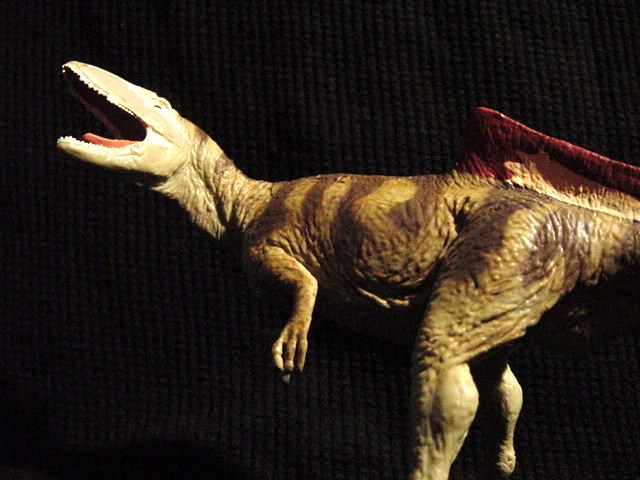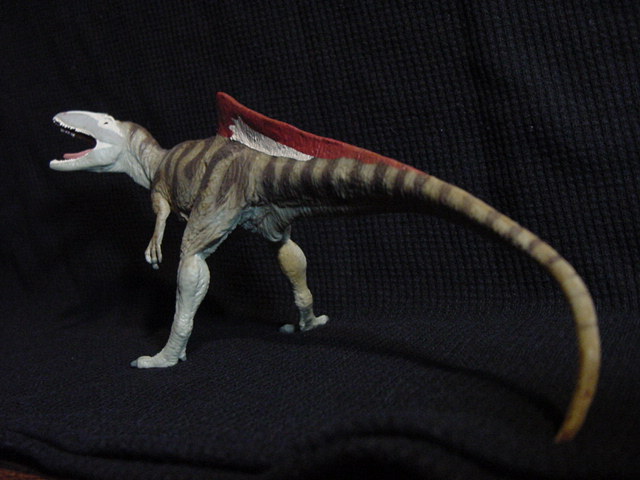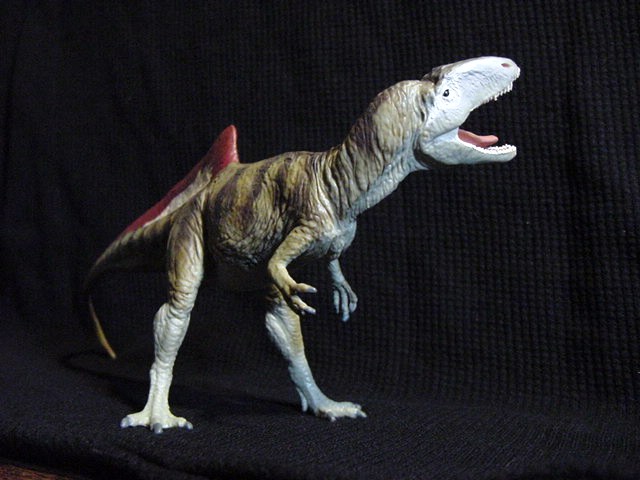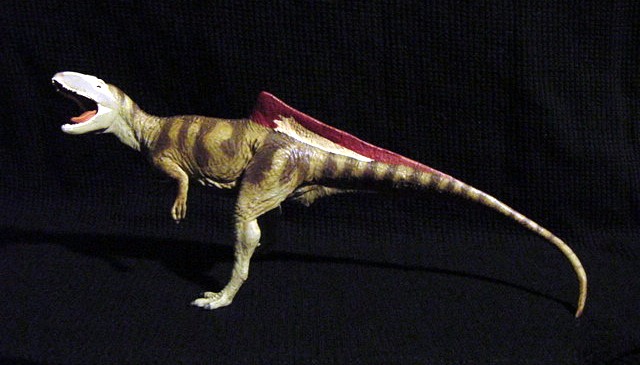In recent years, the fossil beds of Spain have provided spectacular examples of dinosaurs, but perhaps the most famous is Concavenator. First revealed in 2010, this allosauroid’s distinctive physique made it an instant celebrity. The peculiar hump along the back does not seem as awe-inspiring as the humongous sails lining the backs of certain other critters, yet it has clearly made an impression upon us. This distinction is further bolstered by the presence of quill knobs on the forearms – not a new feature to theropods – but certainly piling on mounds of mystique to what might have otherwise been a forgettable, modestly-sized theropod.

It seems that artists have found Concavenator corcovatus to be utterly irresistible. A simple image search online reveals a plethora of pictures for this animal, with many of them carrying quills all over the body. Not even in a Todd Marshall theropod orgy would one expect to find this much quill craziness (and don’t forget Sean Cooper’s amazing sculpt). Given the increasing evidence of theropods with feathery integuments, these reconstructions may not be as far fetched as one might think. While the Carnegie sculptor likely began working on the Concavenator model two years in advance of release, it is strange that this model does not seem to bear a single quill, not even on the forearms. I can only imagine that it was deemed too great a safety issue or manufacturing concern for final production.

The signature dorsal hump has been assigned at least two possible functions. The first is thermoregulation, which is not a terribly easy feature for an artist to convey. The second proposed function is display, perhaps strutting about in courtship rituals. This is another opportunity that an artist simply cannot pass up, and Concavenator’s signature feature is almost always adorned in some sort of flashy color. In many reconstructions, it bears a reddish hue, contrasted with the more neutral tones of the body. In some cases, this can actually make the bulk of the animal look comparatively boring (see the CollectA Concavenator of 2011). For the Carnegie reconstruction, this is certainly not the case. The basic cream color becomes a more sand-like tone toward the center of the body, while the flanks are streaked in brown. This ensures that even without the hump, this model would still be interesting to look at.

The display hump has also been given more than the typical splash of red. The red actually appears in a long band over what can only be described as a creamy middle. This effect helps the red stand out, to a greater extent than if the entire hump had been coated in a single color. It could also be a clever way to avoid the mistaken impression of a wounded animal (see the original Carnegie Miragaia sculpture, which had only red along the neck without the counterbalance of blue). My only gripe is that the colors seem duller than the original prototype stock photo. Given the strong visual impression of last year’s Carnegie Carnotaurus model, I had hoped for a slightly more striking appearance. It is difficult to argue with the choice of red for exuding sexual energy, of course. If Les Misérables has taught us anything, it’s that red is the color of desire, yes?

Crafting this piece at 1:25 scale has enabled considerable detail to be filled into its 18 centimeter form, though it will no doubt continue to irritate Carnegie traditionalists yearning for the days of consistent 1:40 scale models. As with most Carnegie figures, this model does reveal the substantial research that went into its design, making it a very accurate representation of the animal. The head conveys the hatchet-like shape of a carcharodontosaurid, the arms are held in the proper position, and the feet are elegantly formed and not oversized “clown feet”. Hopefully these models will start getting attached to bases, so they will not require their tails as a third support leg. Otherwise, it is an excellent example of a very exotic dinosaur, and by far the best available on the mass market today.
Disclaimer: links to Ebay and Amazon on the DinoToyBlog are affiliate links, so we make a small commission if you use them. Thanks for supporting us!




Nagyon szép modell!Sok munkába került ennek a figurának elkészíteni a pompás részleteket.Részemrő az egyik legjobb Carnegie és Concavenator.Mivel spanyol,nevezzük el Hernandeznek.
[…] well. The teeth and eyes are painted sloppily, not nearly as nice as the paint job on the Carnegie Concavenator which has a beautifully painted head. If they can paint the teeth well on that head, why can’t […]
NO BASES. Then the figures would be ruined. I can live with ‘clown feet’ and tripods, but bases (like Pachycephalosaurus) make my hardplastics into displays, not things you can play with
Well,the pose is a bit different to the Stock photo.In the Stock photo It’s similar to their Giganotosaurus ,but the final model is more similar to the Cryolophosaurus.I love this model.It’s one of this year best releases,in my opinion.
To allow figures to be stable on two legs without making them a tripod, giving them oversized feet, or attaching them to a base, isn’t all that’s necessary to make the feet and legs out of harder plastic? It shouldn’t warp with time or heat. I prefer that option.
The Carnegie Concavenator and Cryolophosaurus both have ‘better’ tripod poses as only the tip of their tail touches the ground so they don’t look unrealistic. Really bad tripods are like all the Carnegie Carnotaurus and the 1996/2007 Carnegie Allosaurus which all look unnatural.
There’s skepticism among experts that Concavenator had quill knobs. That’s probably why there aren’t any quills on this figure. I think it’s unlikely Conc had quills so I like that this figure doesn’t have any.
I think Carnegie makes some of the best dinosaur toys. Something I think lets it down is that most of their figures of more famous prehistoric animals look terrible! Examples: Carnegie Stegosaurus, Allosaurus, Pteranodon, Parasaurolophus, Quetzalcoatlus, Velociraptor, Dilophosaurus. I find all those animals more interesting than Concavenator, which I think looks weird and is quite boring. So I’m not that pleased Carnegie chose to make it and not remake more interesting animals like the ones mentioned previously. It’s good for those who like Concavenator though!
I like this figure. I like the lighter coloring on the head. I like it’s overall daintiness. I actually don’t mind the tripod stance on this particular figure, but with a little manipulation of the angle of the feet, it could probably be made to stand without the tail’s support, as it stands well without the tail on objects with the same angle as the feet.
In my opinion this figure is wonderful.Some people says the Carnegie giganotosaurus and this Concavenator are similars.This happen because both two are carcharodontosaurids,and they have similar skulls.We hope next year Safari ltd continue adding ceratopsians in the Wild Safari range,and a Wild Safari Yutyrannus appear next year.Fantastic figure this Concavenator corcovatus.
I find this one pretty nice to be honest, it occurs to me that you could mod this into pretty much any Carcharodontosaur if you cut off the spine.
Como ya es habitual en esta marca,la escultura es muy buena,sin embargo es una lástima que persistan con la pose tipo “trípode”,todos los terópodos de esta firma llevan la cola como apoyo (giganotosaurus,spinosaurus,cryolophosaurus,etc…),lo que les hace resultar un poco estáticos y perder parte de su encanto.Otras marcas teóricamente inferiores como Collecta están arriesgando más y sacan posturas más originales y atrevidas (Daspletosaurus,por ejemplo.).
Whoever doesn’t appreciate the form of this unique figure is spoilt.Whenever some company sends out an unusual or new dino to the toy world,it is usually something for collectors to throw a party over.But instead I see a bunch of poor comments.Companies put a lot of time and money into these figures and I’ll bet this very minute they are planning 2014’s series of new figures.
We as consumers are allowed to say that we don’t like something. This is a discussion blog: we’re here to discuss aspects of toys we may or may not like. It’s not always lollipops and rainbows- sometimes companies make poor products.
“Companies put a lot of time and money into these figures”- this isn’t a charity. We’re not buying these toys because we feel obligated to pay the company back or something. The average Carnegie toy is not cheap- and coupled with the fact that this figure has a poor paintjob, uninspired pose and nearly recycled sculpt, some of us were not pleased with it (plus the fact that Carnegie only put out ONE figure a year, was a major disappointment). If you don’t like seeing “poor comments” then you shouldn’t be on the internet.
Also, how is the form of this figure “unique”? It’s basically recycled from the Carnegie Giganotosaurus. Even the CollectA Concavenator was better than this, at least the sculpt was more original.
No-one “throws a party” when Schleich releases a dinosaur toy, but I don’t see you complaining about that..Funny.
I don’t think the CollectA Concavenator is better than this one. The pose might be better, but the figure looks awful! Different strokes for different folks!
Very poor detail, and a lame pose. And the paint job – well, it speaks for itself.
A “swing and a miss” by Carnegie ….
I’ll pass on this one, it’s very boring and so-so :/